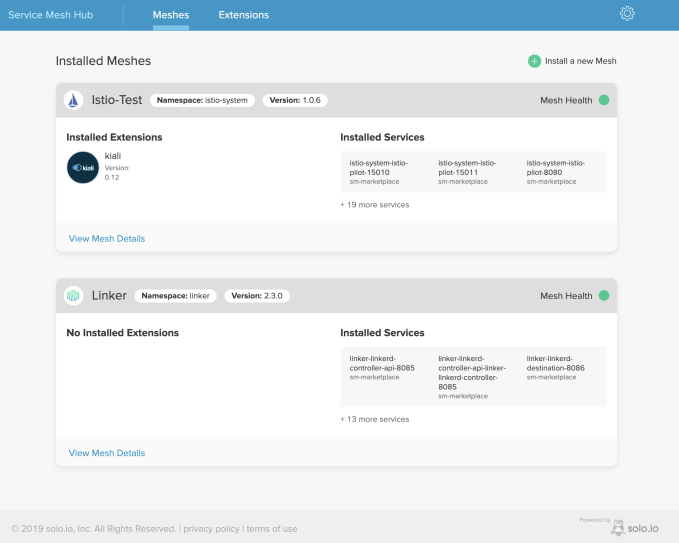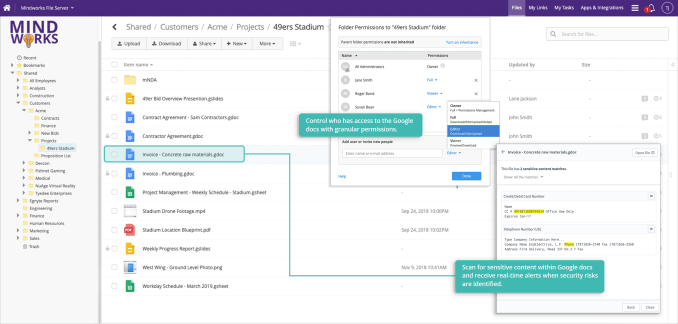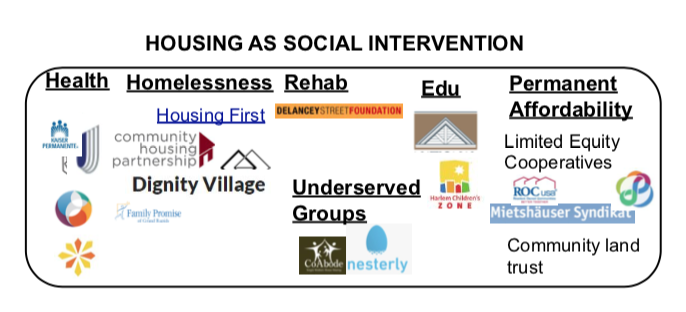Solo.io wants to bring order to service meshes with centralized management hub
As containers and microservices have proliferated, a new kind of tool called the service mesh has developed to help manage and understand interactions between services. While Kubernetes has emerged as the clear container orchestration tool of choice, there is much less certainty in the service mesh market. Solo.io today announced a new open-source tool called Service Mesh Hub, designed to help companies manage multiple service meshes in a single interface.
It is early days for the service mesh concept, but there are already multiple offerings, including Istio, Linkerd (pronounced Linker-Dee) and Envoy. While the market sorts itself it out, it requires a new set of tools, a management layer, so that developers and operations can monitor and understand what’s happening inside the various service meshes they are running.
Idit Levine, founder and CEO at Solo, says she formed the company because she saw an opportunity to develop a set of tooling for a nascent market. Since founding the company in 2017, it has developed several open-source tools to fill that service mesh tool vacuum.
Levine says that she recognized that companies would be using multiple service meshes for multiple situations and that not every company would have the technical capabilities to manage this. That is where the idea for the Service Mesh Hub was born.
It’s a centralized place for companies to add the different service mesh tools they are using, understand the interactions happening within the mesh and add extensions to each one from a kind of extension app store. Solo wants to make adding these tools a simple matter of pointing and clicking. While it obviously still requires a certain level of knowledge about how these tools work, it removes some of the complexity around managing them.

Solo.io Service Mesh Hub (Screenshot: Solo.io)
“The reason we created this is because we believe service mesh is something big, and we want people to use it, and we feel it’s hard to adopt right now. We believe by creating that kind of framework or platform, it will make it easier for people to actually use it,” Levine told TechCrunch.
The vision is that eventually companies will be able to add extensions to the store for free, or even at some point for a fee, and it is through these paid extensions that the company will be able to make money. She recognized that some companies will be creating extensions for internal use only, and in those cases, they can add them to the hub and mark them as private and only that company can see them.
For every abstraction it seems, there is a new set of problems to solve. The service mesh is a response to the problem of managing multiple services. It solves three key issues, according to Levine. It allows a company to route the microservices, have visibility into them to see logs and metrics of the mesh and to provide security to manage which services can talk to each other.
Levine’s company is a response to the issues that have developed around understanding and managing the service meshes themselves. She says she doesn’t worry about a big company coming in and undermining her mission because she says that they are too focused on their own tools to create a set of uber-management tools like these (but that doesn’t mean the company wouldn’t be an attractive acquisition target).
So far, the company has taken more than $13 million in funding, according to Crunchbase data.
Powered by WPeMatico
Egnyte brings native G Suite file support to its platform
Egnyte announced today that customers can now store G Suite files inside its storage, security and governance platform. This builds on the support the company previously had for Office 365 documents.
Egnyte CEO and co-founder Vineet Jain says that while many enterprise customers have seen the value of a collaborative office suite like G Suite, they might have stayed away because of compliance concerns (whether that was warranted or not).
He said that Google has been working on an API for some time that allows companies like Egnyte to decouple G Suite documents from Google Drive. Previously, if you wanted to use G Suite, you no choice but to store the documents in Google Drive.
Jain acknowledges that the actual integration is pretty much the same as his competitors because Google determined the features. In fact, Box and Dropbox announced similar capabilities over the last year, but he believes his company has some differentiating features on its platform.
“I honestly would be hard pressed to tell you this is different than what Box or Dropbox is doing, but when you look at the overall context of what we’re doing…I think our advanced governance features are a game changer,” Jain told TechCrunch.
What that means is that G Suite customers can open a document and get the same editing experience as they would get were they inside Google Drive, while getting all the compliance capabilities built into Egnyte via Egnyte Protect. What’s more, they can store the files wherever they like, whether that’s in Egnyte itself, an on-premises file store or any cloud storage option that Egnyte supports, for that matter.

G Suite documents stored on the Egnyte platform
Long before it was commonplace, Egnyte tried to differentiate itself from a crowded market by being a hybrid play where files can live on-premises or in the cloud. It’s a common way of looking at cloud strategy now, but it wasn’t always the case.
Jain has always emphasized a disciplined approach to growing the company, and it has grown to 15,000 customers and 600 employees over 11 years in business. He won’t share exact revenue, but says the company is generating “multi-millions in revenue” each month.
He has been talking about an IPO for some time, and that remains a goal for the company. In a recent letter to employees that Egnyte shared with TechCrunch, Jain put it this way. “Our leadership team, including our board members, have always looked forward to an IPO as an interim milestone — and that has not changed. However, we now believe this company has the ability to not only be a unicorn but to be a multi-billion dollar company in the long-term. This is a mindset that we all need to have moving forward,” he wrote.
Egnyte was founded in 2007 and has raised more than $137 million, according to Crunchbase data.
Powered by WPeMatico
In travel tech, 4 rivals merge in Europe to form Altido for property management of Airbnb-style homes
The growth of Airbnb and other big travel startups has given a fillip to the wider travel industry, and today several smaller startups in the short-term property sector are announcing that they have merged to tackle the opportunity with more scale.
The UK’s BnbBuddy and The London Residents Club, along with both Hintown from Italy and RentExperience from Portugal — all companies that help manage properties that are listed on platforms like Airbnb — have combined to form a new startup called Altido.
Going into the merger, all four were profitable, having all been boostrapped from day one. But Michael Allen, the MD of the BnbBuddy, said that now the combined entity is using its scale and raising outside funding to grow the business. Altido is looking to raise a Series A in the tens of millions of dollars. It is not disclosing its valuation currently although the fact that it already has an international presence and profitability have helped it in this area, Allen said.
The combined company will have about 1,700 properties under management in 21 European destinations, which it will be using as the anchor for an aggressive push both on existing markets as well as other parts of Europe and beyond. There is a long way to go: as a point of comparison, when Guesty — which provides services to manage rentals of private homes on Airbnb and other services — announced $35 million in funding in March, the number of properties managed on its platform had reached 100,000 across 70 countries.
Other competitors will include the platforms themselves where these properties are getting listed: as Airbnb inches to an IPO, it’s adding ever more services and features to its platform to diversify its revenue streams and also bring in more revenues per customer. (As we’ve said before, that could also make Altido and others like it acquisition targets.)
The growth of Altido’s individual businesses up to now has been on the back of the massive growth surge we’ve seen around platforms — marketplaces, to be more precise — that help people easily list and rent out travel accommodation in private homes as an alternative to hotels; and would-be visitors to find, book and pay for these in an efficient and reliable way, alongside a wider growth of self-catering accommodations that exist as alternative to traditional hotels.
The wider market for “homesharing”, as the first of these categories is sometimes called, has become massive — with Airbnb, the outsized startup leading the charge, now valued at $35 billion — and it now accounts for some 20 percent of the supply of rooms globally by Altido’s estimate.
Some property owners are happy to play host and run and manage their own listings on these platforms — which include the likes of Airbnb, Homeaway and VRBO, and many others — but a big part of the scaling of these services has come by way of third-party management companies that handle different aspects of those listings, from cleaning before and after guests and stocking kitchens and bathrooms with consumables; to managing the relationship with the visitors; to managing the listings themselves.
Altido provides an end-to-end service for those who do not want to play host, alongside a business where it also helps maintain and manage service apartments and aparthotels and guesthouses.
Today the companies that make up Altido rely on third-party platforms to disseminate all those listings, but longer-term, the plan will be to build out more services to offer listings directly as well, alongside more technology to help hosts and other management companies optimise pricing and details around the properties themselves to make them more attractive.
“We see tech as a big enabler,” Goncalo Ribeiro, the founder of RentExperience, said in an interview. He said that his company already has proprietary algorithms that it uses to help calculate property risk factors, which it already uses and will roll out across the whole of the merged company, and the different operations have already been building technology to help onboard properties more efficiently. Areas that it hopes to address include “regulation risk, potential growth rates, historic market data, marketing calculations and more. Any decision we take we want to be proven by data.”
Powered by WPeMatico
India’s ride-hailing firm Ola is now in the credit card business, too
A day after India’s largest wallet app Paytm entered the credit card business, local ride-hailing giant Ola is following suit. Ola has inked a deal with state-run SBI and Visa to issue as many as 10 million credit cards in the next three and a half years, it said today.
The move will help Visa and SBI (State Bank of India) acquire more customers in India, where most transactions are still bandied out over cash. For Ola, which rivals Uber in India, the foray into credit cards represents a new avenue to monetize its customers, as TechCrunch previously reported.
With about 150 million users availing more than 2 million rides on its platform each day, Ola is sitting on a mountain of data about its users’ financial power and spends. With the card, dubbed Ola Money-SBI Credit Card, the mobility firm is also offering several discounts and savings to retain its loyal customer base.
Ola, which is nearing $6 billion in valuation and counts SoftBank and Naspers among its investors, said it will offer its credit card holders “highest cashback and rewards” in the form of Ola Money that could be redeemed for Ola rides, as well as flight and hotel bookings. There will be 7% percent cashback on cab spends, 5% on flight bookings, 20% on domestic hotel bookings (6% on international hotel bookings), 20% on more than 6,000 restaurants and 1% on all other spends.
In an interview with TechCrunch, Nitin Gupta, CEO of Ola financial services, claimed that the company was offering “five times rewards to customers” in comparison to average credit card companies. “Also, the card is a first of its kind offering that can be managed digitally through the Ola App. We are committed to creating an inclusive ecosystem where mobility and financial services go hand in hand in leading growth and development,” he said. Ola said it has already rolled out the card to some users and will invite other eligible customers to avail it.
“Mobility spends form a significant wallet share for users and we see a huge opportunity to transform their payments experience with this solution. With over 150 million digital-first consumers on our platform, Ola will be a catalyst in driving India’s digital economy with cutting edge payment solutions,” Bhavish Aggarwal, co-founder and CEO of Ola, said in a statement.
Why credit cards?
Ola appears to be following the playbook of Grab and Go-Jek, two ride-hailing services in Southeast Asian markets that have ventured into a number of businesses in recent years. Both Grab and Go-Jek offer loans, remittance and insurance to their riders, while the former also maintains its own virtual credit card. Interestingly, Uber, which also offers a credit card in some markets, has no such play in India.
The move will allow Ola to look beyond ride-hailing and food delivery, two businesses that appear to have hit a saturation point in India, said Satish Meena, an analyst with research firm Forrester.
In recent years, Ola has started to explore financial services. It offers riders “micro-insurance” that covers a range of risks, including loss of baggage and medical expenses. The company said earlier this year, it has sold more than 20 million insurances to customers. Using Ola Money to facilitate cashbacks also underscores Ola’s push to increase the adoption of its mobile wallet, which, according to estimates, lags Paytm and several other wallet and UPI payment apps.
The company has also made a major push in the electric vehicles business, which it spun off as a separate company earlier this year. In March, its EV business raised $300 million from Hyundai and Kia. The company has said that it plans to offer one million EVs by 2022. Its other EV programs include a pledge to add 10,000 rickshaws for use in cities.
Powered by WPeMatico
CrowdStrike, a cybersecurity unicorn, files to go public
If you thought Uber’s disastrous initial public offering last week would deter fellow venture-backed technology companies from pursuing the public markets in 2019, you thought wrong.
CrowdStrike, yet another multi-billion-dollar Silicon Valley “unicorn,” has filed to go public. The cloud-based cybersecurity platform valued at $3.3 billion in 2018 revealed its IPO prospectus Tuesday afternoon.
The company plans to trade on the Nasdaq under the ticker symbol “CRWD.” According to the filing, it intends to raise an additional $100 million, though that figure is typically a placeholder amount. To date, CrowdStrike has raised $480 million in venture capital funding from Warburg Pincus, which owns a 30.3% pre-IPO stake, Accel (20.3%) and CapitalG (11.2%).
As we’ve come to expect of these companies, CrowdStrike’s financials are a bit concerning. While its revenues are growing at an impressive rate, from $53 million in 2017 to $119 million in 2018 to $250 million in the year ending January 31, 2019, its spending is far outweighing its gross profit. Most recently, the company posted a gross profit of $163 million on total operating expenses of about $300 million.
CrowdStrike is not yet profitable. Its total losses are increasing year-over-year from $91 million in 2017, to $135 million in 2018 and $140 million in 2019.
Headquartered in Sunnyvale, the business was founded in 2011 by chief executive officer George Kurtz and chief technology officer Dmitri Alperovitch, former McAfee executives. CrowdStrike, which develops security technology that looks at changes in user behavior on networked devices and uses that information to identify potential cyber threats, has reportedly pondered an IPO for some time.
The business sells its endpoint protection software to enterprises on a subscription basis, competing with Cylance, Carbon Black and others. In its S-1, CrowdStrike makes a case for its offering based on the rise of cloud computing and the growing threat of cybersecurity breaches. It estimates a total addressable market worth $29.2 billion by 2021.
“We founded CrowdStrike in 2011 to reinvent security for the cloud era,” the company writes. “When we started the company, cyberattackers had a decided, asymmetric advantage over existing security products. We turned the tables on the adversaries by taking a fundamentally new approach that leverages the network effects of crowdsourced data applied to modern technologies such as artificial intelligence, or AI, cloud computing, and graph databases.”
Powered by WPeMatico
Innowatts raises $18 million for its energy monitoring toolkit for utilities
Innowatts, an automated toolkit for energy monitoring and management targeting utilities, has raised $18.2 million in a new round of funding from investors led by Energy Impact Partners .
Previous investors Shell Ventures, Iberdrola and Energy and Environment Investment participated along with another new investor, Evergy Ventures.
As utilities respond to new, renewable power coming online and adapt to the challenges presented by natural disasters and intermittent energy sources stressing old power grid assets, they are increasingly turning to new software toolkits to adapt.
Innowatts and its software fit squarely into that category of offering.
“Competing in today’s complex and evolving marketplace requires utility companies use data and intelligence to drive business and customer value,” said Siddhartha Sachdeva, founder and chief executive of Innowatts, in a statement.
The company’s technology is used to analyze meter data from 21 million customers globally in 13 regional energy markets.
Innowatts boasts that it’s the largest body of customer intelligence data consumed by a software company. How that data will be used is an open question.
“We invest in companies driving the transformation of the energy sector towards an increasingly decarbonized, digitized, and electrified future – solutions that our utility partners can commercialize at scale and have the greatest impact,” said Michael Donnelly, partner and chief risk officer at EIP, in a statement. “Innowatts is poised to become a key building block in the software-driven, intelligent grid of the future, and we look forward to working closely with them alongside our utility partners.”
The company uses the data it collects to predict the potential for outages or problems created by surges in energy demand so that utilities can dispatch resources to meet that demand without sacrificing reliability for customers.
“Utilities have the opportunity to deliver more value to customers, at lower costs and with greater personalization than ever before, while helping streamline the complex energy marketplace,” said Geert van de Wouw, vice president of Shell Ventures.
Powered by WPeMatico
New Relic takes a measured approach to platform overhaul
New Relic, the SaaS applications performance management platform, announced a major update to that platform today. Instead of ripping off the Band-Aid all at once, the company has decided to take a more measured approach to change, giving customers a chance to ease into it.
The new platform, called New Relic One, has been designed to replace the original platform, which was developed over the previous decade. The company says that by moving slowly to the new platform, customers will be able to take advantage of new features that it couldn’t have built on the old platform without having to learn a new a way of working.
Jim Gochee, chief product officer at New Relic, says that all of the existing tooling and functionality will eventually be ported over or reimagined on top of New Relic One. “What it is under the covers for us is a new technology stack and a new platform for our offering. We are still running our existing technology stack with our existing products. So we’re [essentially] running two platforms in two stacks in parallel, but all of the new stuff is going to be built on New Relic One over time,” he explained.
By redesigning the existing platform from scratch, New Relic created a new, modern, more extensible model that will allow it to plug in new functionality more easily over time, and eventually even allow customers to do the same thing. For now, it’s about changing what’s happening under the hood and providing a new user experience in a redesigned user interface.
“New Relic One is very pluggable and extensible, which makes it easier for our own teams to build on, and to extend and expand, and also down the road we will eventually get to the point where partners and customers will be able to extend our UI themselves, which is something that we’re very excited about,” he said.
Among the new features is support for AWS Lambda, the company’s serverless offering. It also enables users to search across multiple accounts. It’s not unusual for customers to be monitoring multiple accounts and sub-accounts. With New Relic One, customers can now search across these accounts and find if issues have cascaded more easily.
In a blog post introducing the new platform, CEO Lew Cirne acknowledged the growing complexity of the monitoring landscape, something the new platform has been specifically designed to address.
“Unlike today’s fragmented tools that can deliver a bag of charts and metrics with a bunch of seemingly unrelated numbers, New Relic One is designed to cut through complexity, provide context, and let you see across artificial organizational boundaries so you can quickly find and fix problems,” Cirne wrote.
Nancy Gohring, a senior analyst at 451 Research, says this flexibility is a key strength of the new approach. “One of the most important updates here is the reworked data model which allows New Relic to offer customers more flexibility in how they can search the operations data they’re collecting and build dashboards. This kind of flexibility is more important in modern app environments that are more complex and dynamic than they used to be. Everyone’s environment is different and digging for the cause of a problem is more complicated than it used to be,” Gohring told TechCrunch. The new ability to search across accounts should help with that.
She concedes that having parallel platforms is not ideal, but sees why the company chose to go this route. “Having two UIs is never great. But the approach New Relic is taking lets them get something totally new out all at once, rather than spending time gradually introducing it. It will let customers try out the new stuff at their own pace,” she said.
New Relic One goes live tomorrow, and will be available at no additional cost to New Relic subscribers.
Powered by WPeMatico
Beyond costs, what else can we do to make housing affordable?
Contributor
This week on Extra Crunch, I am exploring innovations in inclusive housing, looking at how 200+ companies are creating more access and affordability. Yesterday, I focused on startups trying to lower the costs of housing, from property acquisition to management and operations.
Today, I want to focus on innovations that improve housing inclusion more generally, such as efforts to pair housing with transit, small business creation, and mental rehabilitation. These include social impact-focused interventions, interventions that increase income and mobility, and ecosystem-builders in housing innovation.
Nonprofits and social enterprises lead many of these innovations. Yet because these areas are perceived to be not as lucrative, fewer technologists and other professionals have entered them. New business models and technologies have the opportunity to scale many of these alternative institutions — and create tremendous social value. Social impact is increasingly important to millennials, with brands like Patagonia having created loyal fan bases through purpose-driven leadership.
While each of these sections could be their own market map, this overall market map serves as an initial guide to each of these spaces.
- Social impact innovations
- Landlord-tenant tools
- Innovations that increase income
- Innovations that increase transit accessibility and reduce parking
- Innovations that improve the ability to regulate housing
- Organizations that support the housing innovation ecosystem
- This is just the beginning
- I’m personally closely watching the following initiatives
- The limitations of technology
- Move fast and protect people
Social impact innovations

These innovations address:
Powered by WPeMatico
VR’s most popular game is getting more features (and more expensive)
VR’s most hyped game is getting a price bump later this month as it expands the amount of headsets that it’s playable on.
We did a big deep-dive last week on Beat Saber, the best seller from a tiny Prague VR studio that’s pulling in big revenues. The game is part Guitar Hero, part Fruit Ninja, and you’ve got some light sabers to guide you through EDM tunes. It’s sold over 1 million copies.
This week, the company Beat Games shared some updates that are likely to increase those revenues further as the company grows more confident that they’ve ironed out most of the game’s bugs.
On May 21, Beat Games is bumping the price from $20 to $30 on Valve’s Steam store and the Oculus Home platform, bringing the price in line with the PS VR version. This price bump comes as the company abandons the “Early Access” title, a classifier that has long signified that a game is in beta and hasn’t had all of the kinks ironed out. With this, the studio detailed in a Medium post, they feel the game has reached a “stable version,” and that it is now a “full game.”
When the game exits early access, it will be picking up a long-promised level editor so that gamers can create custom levels for their own audio tracks.
The price change on May 21 isn’t an arbitrary date, that’s when Oculus will be releasing both of its new headsets, the Rift S and Quest.
Speaking of the Quest, Oculus had introduced a feature called cross-buy that would enable users who already owned a copy of a game on Rift to let users download that game for free on Quest. On Twitter, Beat Games noted today that they won’t be supporting this for the base game, so Quest users will still have to pay up, though the studio said they will enable the feature for add-ons like additional music packs.
Beat Saber is going to be unified across all platforms moving forward, meaning you won’t see certain versions getting updates that the others won’t get for a while. This opens up the potential for cross-platform multiplayer as the studio continues to work on a mode for multiple concurrent users.
The price jump comes next week, you’ll still be able to score the game at the Early Access price before May 21.
Powered by WPeMatico
Google makes travel planning easier
Google today announced a major revamp of its travel planning tools on the web. After launching a similar set of tools on mobile last year, the company today announced that google.com/travel on the web will now let you see information about all of your previously reserved trips and easily switch between flight, hotel and package searches.
In many ways, this finally brings all of Google’s travel services under one hood — a process that has taken far longer than I would’ve anticipated after Google bought ITA nine years ago.
Google Trips is essentially the landing page for the new site and brings together your existing bookings and information about your destination. The service will then feed your travel information back into Google Search and Maps. To do this, Google.com/travel (which I think we can safely call Google Travel, even if Google itself doesn’t do so), will use the confirmation emails and receipts from your Gmail inbox to build the timeline of your trip.
Because both the web and mobile versions are now on feature parity, this also makes it easier to pick up your trip planning on any device. Like always, though, you won’t be able to make any reservations through Google’s systems. Instead, Google will send you to an airline’s or hotel’s reservation system to complete a booking.
The actual flight and hotel search engines are still the same, though if Google previously offered the ability to buy flight and hotel packages, it did a good job of hiding that. Now, this option gets first billing, together with the hotel and flight searches.
“Our goal is to simplify trip planning by helping you quickly find the most useful information and pick up where you left off on any device. We’ll continue to make planning and taking trips easier with Google Maps, Google Search and google.com/travel—so you can get out and enjoy the world.”
Sadly, Google hasn’t ported Inbox’s useful Trip Bundles over to Gmail yet, though, despite promises to do so before shutting down Inbox. For the time being, the new Google Travel site is a pretty good alternative.
Powered by WPeMatico


